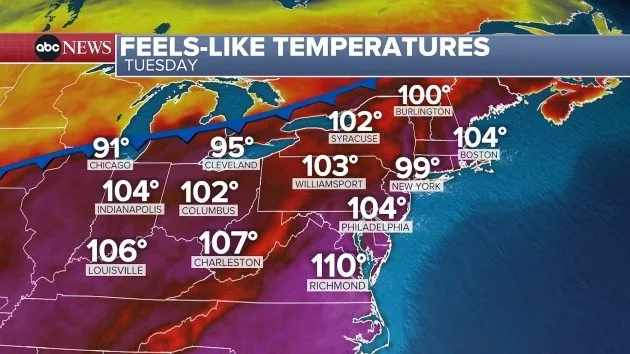(NEW YORK) — A dangerous heat wave has set in, leaving nearly 150 million people from Texas to Maine under heat alerts on Monday.
In some regions of the country, including the Northeast, thermometers are expected to rise this week to the highest temperatures in more than decade.
Nearly 50 cities could see daily high temperature records broken, including New York City, Philadelphia and Washington, D.C.
“This level of HeatRisk is known for being rare and/or long duration with little to no overnight relief, and affects anyone without effective cooling and/or adequate hydration,” the National Weather Service (NWS) said in an advisory issued Monday morning.
A heat wave is a continuous period of abnormally hot weather, generally lasting over two days, according to the NWS.
However, the definition of a heat wave varies by region. In the Midwest and the Northeast, a heat wave is defined as three or more consecutive days of at least 90 degrees.
On Monday, the heat index, a measurement of what the sweltering weather feels like as opposed to the actual temperature reading, is forecast to soar above 100 degrees for much of the Northeast and Mid-Atlantic, as well as in the Midwest from Cedar Rapids, Iowa, to Memphis, Tenn.
Philadelphia is forecast to reach a high of 100 degrees on Monday, a temperature the city hasn’t seen since July 2012.
In anticipation of the first heat wave of the season, Philadelphia city officials declared a heat health emergency that began at noon on Sunday and will stay in place until at least 8 p.m. on Wednesday.
Dr. Palak Raval-Nelson, Philadelphia’s health commissioner, said a heat health emergency is declared when the temperature gets high enough to increase “the risk of getting sick or dying from the heat” — especially for elderly people, individuals with chronic medical conditions and pregnant women.
“The best way to protect our loved ones is to make sure they can get into air conditioning during the hottest part of the day,” Raval-Nelson said in a statement.
Philadelphia is opening more than 40 cooling centers across the city to help people beat the heat.
In New York City, the temperature surpassed 90 degrees by 11 a.m. and expected to rise to the mid-90s to upper 90s on Monday afternoon and reach the upper 90s on Tuesday.
The last time New York City hit 100 degrees was in July 2012.
“Extreme heat will not just be uncomfortable and oppressive for New Yorkers this coming week, it will be brutal and it will be dangerous,” New York City Mayor Eric Adams said in a statement.
On Tuesday, temperatures across the Northeast and Midwest are expected to be slightly higher than on Monday, and the heat index will make cities like Syracuse, New York, and Burlington, Vermont, feel over 100 degrees.
Nighttime temperatures are expected to provide little relief and could be particularly dangerous for people without air conditioning. Overnight temperatures are forecast to be hovering near 80 degrees.
The heat wave is expected to subside on Wednesday, but it will take until Thursday for much of the eastern United States to see real relief from the extreme temperatures.
Elsewhere across the country, the cold front that will help break the heat wave will move through the upper Midwest, producing severe thunderstorms from Kansas to Michigan. The primary risks for the Midwest will be damaging winds, hail, flash flooding and the possibility of tornadoes.
Copyright © 2025, ABC Audio. All rights reserved.






